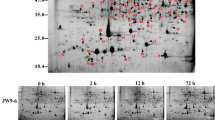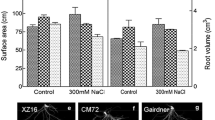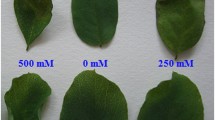Abstract
A significant decrease in the amount of a protein, whose migration in two-dimensional gel electrophoresis corresponds to an apparent molecular mass of 23 kDa and pI=6.5, was observed in leaves of NaCl-treated Bruguiera parviflora (Roxb.) Wt. & Arn. ex Griff. seedlings. This particular salt-sensitive protein, designated as SSP-23, almost disappeared after 45 days of treatment in 400 mM NaCl as compared to untreated seedlings (0 mM NaCl) where the presence of the protein was significant. A polyclonal antibody raised against the 23-kDa protein was used to determine the subcellular localization of this protein in leaves by cross-reaction with proteins from isolated chloroplasts, mitochondria, peroxisomes and cytosol fractions on Western blots. SSP-23 was confirmed to be localized in the cytosol by immunoblotting. The disappearance of SSP-23 as a result of high NaCl treatment suggests that this protein is salt-sensitive and has a possible role in salt adaptation.





Similar content being viewed by others
Abbreviations
- 2-D :
-
Two dimensional
- PAGE :
-
Polyacrylamide gel electrophoresis
- SDS :
-
Sodium dodecyl sulfate
- SSP :
-
Salt-sensitive protein
References
Bray EA (1993) Molecular responses to water deficit. Plant Physiol 103:1035–1040
Bradford MM (1976) A rapid and sensitive method for the quantitation of microgram quantities of proteins utilizing the principle of protein–dye binding. Anal Biochem 72:248–254
Das AB, Parida A, Basak UC, Das P (2002) Studies on pigments, proteins and photosynthetic rates in some mangroves and mangrove associates from Bhirarkanika, Orissa. Mar Biol 141:415–422
Flowers TJ (2004) Improving crop salt tolerance. J Exp Bot 55:307–319
Flowers TJ, Troke PF, Yeo AR (1977) The mechanism of salt tolerance in halophytes. Annu Rev Plant Physiol 28:89–121
Haines J, Patel PD (1997) Antibody- and lectin-based assays for the rapid analysis of food-grade gums and thickeners. Trends Food Sci Technol 81:395–400
Hasegawa PM, Bressan RA, Zhu JK, Bohnert HJ (2000) Plant cellular and molecular responses to high salinity. Annu Rev Plant Physiol Plant Mol Biol 51:463–499
Hassanein AM (1999) Alterations in protein and esterase patterns of peanut in response to salinity stress. Biol Plant 42:241–248
Hoagland DR, Arnon DI (1940) Crop production in artificial solutions and in soil with special reference to factors influencing yield and absorption of inorganic nutrients. Soil Sci 50:463–471
Hurkman WJ, Tanaka CK (1986) Solubilization of plant membrane proteins for analysis by two-dimensional gel electrophoresis. Plant Physiol 81:802–806
Hurkman WJ, Fornia CS, Tanaka CK (1989) A comparison of the effects of salt on polypeptides and translatable mRNAs in roots of a salt-tolerant and salt-sensitive cultivar of barley. Plant Physiol 90:1444–1456
Laemmli UK (1970) Cleavage of structural proteins during the assembly of the head of bacteriophage T4. Nature 227:680–685
Lopez F, Vansuyt G, Fourcroy P, Casse-Delbart F (1994) Accumulation of a 22-kDa protein in the leaves of Raphanus sativus in response to salt stress or water deficit. Physiol Plant 91:605–614
Moore AL, Proudlove MO (1983) In: Hall JL, Moore AL (eds) Isolation of membranes and organelles from plant cells. Academic Press, London, pp 153–158
O’Farrell PH (1975) High resolution two-dimensional electrophoresis of proteins. J Biol Chem 250:4007–4021
Parida A, Das AB, Das P (2002) NaCl stress causes changes in photosynthetic pigments, proteins and other metabolic components in the leaves of a true mangrove, Bruguiera parviflora, in hydroponic cultures. J Plant Biol 45:28–36
Parida AK, Das AB, Mittra B, Mohanty P (2004) Salt stress induced alterations in protein profile and protease activity in the mangrove Bruguiera parviflora. Z Naturforsch Teil C 59:408–414
Robinson SP (1982) Transport of glycerate across the envelope membrane of isolated spinach chloroplasts. Plant Physiol 70:1032–1038
Suigihara K, Hanagata N, Dubinsky Z, Baba S, Karube J (2000) Molecular characterization of cDNA encoding oxygen evolving enhancer protein 1 increased by salt treatment in the mangrove Bruguiera gymnorhiza. Plant Cell Physiol 41:1279–1285
Swire-Clark GA, Marcotte WR Jr (1999) The wheat LEA protein Em functions as an osmoprotective molecule in Saccharomyces cerevisiae. Plant Mol Biol 39:117–128
Tamas L, Huttova J, Mistrik I (2001) Impact of aluminium, NaCl and growth retardant tetcyclasis on growth and protein composition of maize roots. Biologia 56:441–448
Towbin H, Staehelin T, Gordon J (1979) Electrophoretic transfer of proteins from polyacrylamide gels to nitrocellulose sheets: procedure and some applications. Proc Natl Acad Sci USA 76:4350–4354
Unni S, Rao KK (2001) Protein and lipopolysaccharide profiles of a salt-sensitive Rhizobium sp and its exopolysaccharide-deficient mutant. Soil Biol Biochem 33:111–115
Walzel H, Bremer H, Neels P, Jonas L, Brock J (1991) Preparation of neoglycoprotein using a homobifunctional reagent and its applicability for protein blotting and electron microscopy. Biomed Biochim Acta 50:151–157
Xu D, Duan X, Wang B, Hong B, Ho TDH, Wu R (1996) Expression of a late embryogenesis abundant protein gene, HVA1, from barley confers tolerance to water deficit and salt stress in transgenic rice. Plant Physiol 110:249–257
Xu XY, Abo M, Okubo A, Yamazaki S (2001) Salt-stress-responsive membrane proteins in Rhodobacter sphaeroides f. sp denitrificans IL106. J Biosc Bioeng 91:228–230
Zemel E, Gepstein S (1985) Immunological evidence for the presence of ribulose biphosphate carboxylase in guard cell chloroplasts. Plant Physiol 78:586–590
Acknowledgements
The authors are grateful to Prof. P. Das, Director, Regional Plant Resource Centre, Bhubaneswar for providing laboratory facilities. The financial assistance from CSIR (Grant No. 38(983)/EMR-II), New Delhi, is duly acknowledged.
Author information
Authors and Affiliations
Corresponding author
Rights and permissions
About this article
Cite this article
Parida, A.K., Mittra, B., Das, A.B. et al. High salinity reduces the content of a highly abundant 23-kDa protein of the mangrove Bruguiera parviflora. Planta 221, 135–140 (2005). https://doi.org/10.1007/s00425-004-1415-2
Received:
Accepted:
Published:
Issue Date:
DOI: https://doi.org/10.1007/s00425-004-1415-2




